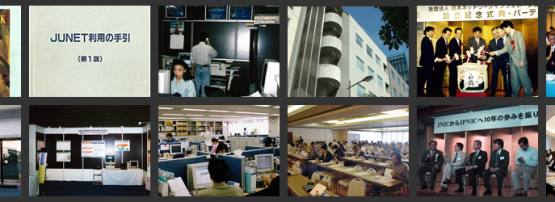
We have had a lot of ‘Internet anniversaries’ in the past few years.
When I stayed at the Crowne Plaza Cabana Hotel in Palo Alto, California, USA, I found a plaque which said “Vint Cert and Robert Kahn designed the Internet Architecture and the TCP Specification here in 1973”. What a historic hotel it was! Yes, 2013 was the fortieth anniversary of TCP, or even of the ‘Internet Architecture’ as it says.
In 2013, APNIC had its twentieth anniversary; so did JPNIC – its foundation year is shared with APNIC (by the way, JNIC was founded in 1991, if you are interested). JPNIC celebrated the twentieth anniversary in September 2013 with the members.
Just as APNIC ran the “APNIC History Project”, my colleagues at JPNIC and Japan Registry Services (JPRS)– which was spun off from JPNIC to succeed and expand .JP ccTLD management– and I have been working on our own history project for half a decade. I am sure the desire to record history is shared by all Internet people. The more senior ones of us especially remember events of more than a decade ago as though it were yesterday.
I classify myself as “second generation” who got into the Internet following the pioneers. I learned a number of important things from them. The Internet is not only built of the technologies, but also the social system that manages and evolves the infrastructure of the network, as well as the global Information Society. The current JPNIC and JPRS, among a lot of institutions and schemes, are all built on collective events, collaborations, coordination and decisions which have occurred since the emergence of the Internet. There is no doubt that they should be recorded to be referred to by the generations now and in order to craft the future Internet.
The project team’s first outcome was released as 24 page booklet (in Japanese) at JPNIC’s twentieth anniversary in September 2013 and distributed to JPNIC members. We made it concise enough to produce as a paper publication for the anniversary event. But we felt it didn’t cover enough, so we spent another year expanding, improving and digging into the detail, and published a web version of “History of Internet Resources Management in Japan – Focusing on Domain Name and IP Address” (in Japanese) in November 2014.
The documents are in Japanese because the foci of JPNIC and JPRS are on serving Japanese community, thus we expected Japan to be the primary audience. However, with few English documents describing the Internet in Japan and with a belief that work the ‘frontier countries’ did to develop the Internet should be accessible to the others, we translated it into English for the global audience. It was finally made available to the public on May 7, 2015!
This history covers from 1980s to 2010s and follows the development of the management of IP address and .JP ccTLD, from the initial voluntary basis to the current full-fledged service tackling a number of issues. Ten chapters are not strictly divided by chronology but by themes. Many chapters describe what happened in Japan, while others describe global movements. Much of it is from Japan’s perspective, but I believe it is interesting for the global audience to have a perspective on the development of the Internet that doesn’t focus on the US.
Another English language outcome of the project is a web-browsable “Internet Timeline” where events are laid out in chronological order. It’s very nice to get what happened when!
Gerard Ross, the former Communication Manager at APNIC, who also compiled the history of APNIC, kindly took the role of proofreading this time. It was my delight to work with my old friend and the text has been much improved. Thank you, Gerard!
We do hope these publications will be of good reference and interest, and your comments are more than welcome at history-comment@nic.ad.jp .
Maemura Akinori is currently the General Manager of the Internet Development Department at the Japan Network Information Center (JPNIC). He is the Chair of the APNIC Executive Council, and a member since 2000.
The views expressed by the authors of this blog are their own and do not necessarily reflect the views of APNIC. Please note a Code of Conduct applies to this blog.
